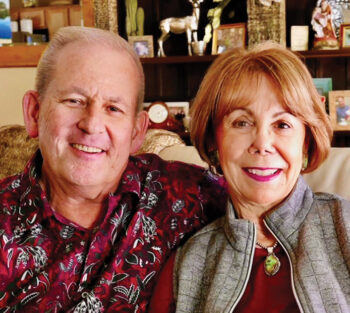
Lyle Larson and his wife Jen Jefferis
Lyle Larson
There is no way a person with relatively normal hearing can understand what it’s like for people with hearing loss. I am blessed with good hearing in my later years, but my wife is not as fortunate, and it’s been an interesting journey for both of us.
Although she had experienced some degree of hearing loss for years, shortly after we retired to SaddleBrooke in 2015 she experienced a profound deficit in her hearing.
It’s really difficult to enjoy life in SaddleBrooke when one can’t hear the speaker at events in the ballroom, music at the Performing Arts Center, or even friends at dinner in restaurants. I saw my wife experience feelings of helplessness and begin to withdraw from socializing. Our life at home suffered as well. No longer could we carry on a conversation at a distance and I became the resident ears for the house. She had difficulty hearing the doorbell, phone ring, or even a pot boiling on the stove.
Fortunately, we soon met a couple who had already been down this road with one of them experiencing profound hearing loss and the other trying to cope. They had some great ideas, the first of which was a class at the University of Arizona on how to deal with hearing loss. Although it usually takes a person on average seven to 10 years to acknowledge their hearing loss and seek help, my wife was determined to improve her hearing and her quality of life.
The class at the university taught my wife strategies to improve our communication, such as walking to the person before speaking, facing each other when talking (people with hearing loss read lips), and speaking slowly and clearly. She learned there are different types of hearing loss. While most people experience sensory neural hearing loss from continuous exposure to loud noise, hers was conductive on her right side since she had no functional ear drum. She also discovered there is a device called a BAHA or Bone Anchored Hearing Aid, which enables her to hear through her bone. Following surgery, recovery, and learning to use the aid, she could hear again. Working with her audiologist, she was also able to use the latest hearing aid technology in her left ear so she could hear on both sides.
It’s important for people with hearing loss to realize even with the help of an audiologist and the proper hearing devices, one’s hearing will never be the way it was before. My wife’s hearing is improved, but she still struggles to hear at times.
The path to better hearing is a journey, and the two most important support systems are the audiologist and a partner or friend. I’m so proud of the effort my wife puts into improving her hearing. She has her hearing tested annually and continually works with her audiologist either in person or via email to make adjustments to her devices. She also has such a heart for those with hearing loss she started a support group here in SaddleBrooke that meets every month. Her name is Jennifer Jefferis.
To join the monthly Zoom meetings of the SaddleBrooke Discussion Group for Better Hearing, please contact Maria Menconi at [email protected].
Otherwise, for information about the Discussion Group for Better Hearing contact Jennifer Jefferis at [email protected] or by phone at 360-909-6212.
